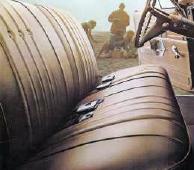
In one of my very early blog entries (#0006, The poison apple), I mentioned the Ackerman house, up a hill from my childhood home, with its large lawn. In the summer, the Ackermans frequently had their land fogged with the insecticide DDT, to cut down on the number of irritating mosquitoes. Although I don't have any actual photographs of this operation, the picture to the left shows a similar scene (note the bicycles at the lower right that evidently brought children to the event). My sisters and I and other neighboring children used to love to run behind the cart emitting the insecticidal fog. It was fun to run through the clouds, and the fog had a rather sweet smell to it, as I recall. We actually did this with the approval of our parents, which nowadays is very hard to imagine. I think that the greater awareness, in our modern times, of the toxicity of many chemicals is a step forward. I mean, it's a poison, for Pete's sake. It kills insects. Looking back, the notion that we lightly tossed off the possibility of any harm in inhaling DDT deeply into our lungs seems to me to be absolutely bizarre. Somehow, in those days, if the authorities said that such an operation posed no threat to human health, we simply accepted these assurances without question. There can be difficulties with the widespread skepticism of today, but overall I think it's an improvement. It's a healthy skepticism. Note 1 Although so far I don't seem to have suffered any ill effects from my youthful inhalation of DDT, there was something in my youth that was much more dangerous: the cars had no seat belts. I discussed this in a previous blog entry called Live free and die. As I noted in it, children just wandered around in the back seat, and for that matter often in the front seat as well. The front passenger seat was even back then referred to as "the death seat", because of the high probability that a passenger seated there would be killed in the event of a serious accident. Like most everyone of my generation, I remember being seated there as a child, and having my mother reach her arm out across my chests when she was forced to make a sudden stop. The purpose of this was to keep me from sliding forward into the dashboard or the windshield. In fact, of course, in a really serious accident, it wouldn't have done a bit of good.
Wanting to transport three couples in a car is, in my experience, a rather frequent event, now requiring two cars. In terms of the number of people carried in a single sedan, those were indeed the good old days. The picture to the right shows a typical bench seat, although it was taken late enough to have seat belts installed. What else was better in my youth? Well, flying was a lot nicer. You just walked onto the airplane. Before a man popularly called D. B. Cooper hijacked a 727 in 1971, there was no particular security inspection upon boarding an aircraft. This is what allowed my sister Phyllis to smuggle a squirrel monkey on board an airplane sometime in the late 60s, an episode which I referred to in my earlier blog entry Grandpa's first flight. Phyllis was flying from Boston to New York on the Eastern Airlines shuttle, and asked me to help her stuff her pet squirrel monkey into a large tote bag. We both donned heavy gloves, and each grabbed the monkey with both hands. The monkey didn't want to go into the bag, and held on tightly to a nearby chair. This presented a problem, because the monkey had one more prehensile appendage than we did. That is, Phyllis and I had only four hands between us. But the monkey had two hands, two prehensile feet, and a prehensile tail. Thus no matter how many limbs (is a tail a limb?) we peeled away from the chair, the monkey always had one additional appendage free to use to grab onto it. Nevertheless, exercising our superior intelligence, we eventually did manage to stuff it into the tote bag and zip the top. By then, Phyllis was getting late for the plane (although if you missed one shuttle, you could always wait an hour and take the next one). As she dashed out the door, the monkey was screaming inside the tote bag. I told her she'd never get it on the plane that way, but she assured me that once it had spent some time in the dark, the monkey would fall asleep and become undetectable. And that is indeed what happened. I hate to think what would have happened, though, had it escaped from the bag and started running up and down the aisle. Note 2 In what other ways were things better in my youth? Well, there are now some pretty serious health threats that didn't exist at all back then. There was no such thing as AIDS ("Acquired Immune Deficiency Syndrome"), and genital herpes was pretty much unknown. The venereal diseases that existed at the time could all be controlled by antibiotics, generally penicillin. Now, despite having a great many more antibiotics available, overuse has bred a great many antibiotic-resistant bacteria. Not that I knew much about any of this as a child. And mosquitoes and ticks were just a nuisance, their bites annoying, but not hazardous. Even when my own children were young, only about 30 years ago, we didn't worry about such things. All the neighborhood children went out into the woods after dark, and played games around the house, with nothing to worry about. Now the local deer ticks, pinhead size, carry Lyme disease, which can become quite serious if not caught early. And our mosquitoes carry West Nile virus, and the even more serious Eastern Equine Encephalitis (called "EEE"), which is very much in the news in the Boston area this fall, and which is frequently fatal. But although we have new health worries, many older concerns have disappeared. Polio, the major threat of my youth, has been essentially eliminated. I had measles and mumps, now vaccinated against. Smallpox was wiped out between my two daughters - the older one has a smallpox vaccination mark on her arm, but the younger one does not. In my youth, we were also given free roadmaps at gasoline filling stations, but that seems like a rather minor matter. I'd much rather have today's GPS ("Recalculating!"). Despite a few things that we've lost, I think we're generally better off today. There are people (particularly in the state of New Hampshire, apparently) who resent the government intrusion of seatbelt laws. But the fact is that tens of thousands of people are alive today who would otherwise be dead or seriously maimed were it not for those laws. In my opinion, this minor intrusion is well worth it. I also love the Internet, with its ability to allow me to instantaneously look up anything I want to know (see my blog entry entitled Google). And I much prefer our vastly expanded freedom of speech compared to the censorship of my youth. Although I don't think I gave it a second thought at the time, it was really pretty outrageous that the movies I could see were limited by Catholic censors, even though I'm not Catholic. Personal computers. Cable television. High definition television. Digital Video Recorders. Cell phones. Smart phones. Cars that last 200,000 miles. Airbags. The Global Positioning System. It's all expensive, but if you don't find it useful, you don't have to buy it. Contraception. The sexual revolution. Vastly increased racial equality. Vastly increased sexual equality. Decreased religious discrimination. Increasing acceptance of homosexuality. Same-sex marriage. It's all better. No, for the most part, I don't long for the good old days.
  Note 1: One of the most bizarre cases of this sort of craziness that I ever saw turned up in a letter to some electronics magazine (I forget which one) many years ago. An engineer told of working, along with a friend of his, in a job which entailed repairing microwave ovens. Arriving at work on particularly cold winter days, he and his buddy would defeat the interlock on an oven that prevented it from operating with the door open. They would then warm their hands and faces in front of the open oven door. The intervening decades had not shown them to have suffered any obvious ill effects from this operation (kids, don't try this at home). I found this letter rather mind-boggling. Microwave ovens are well known for their uneven heating. I would have thought that while experiencing a general warming of their faces in front of the open oven door, there might have been small regions of their head getting seriously cooked. I imagine they limited their exposure to only a few seconds, although they didn't explicitly say that. It was interesting to see, though, that at least for these two people, this high exposure had not produced serious long-term effects, such as, say, cancer. Of course, this is hardly the sort of controlled experiment that really tells us anything. Except maybe that young men are really stupid. [return to text] Note 2: As an aside, I might note that we later discovered that the monkey's high-pitched shriek could not be heard over the telephone. I discovered this quite by accident while standing next to the monkey's cage one day, talking on the phone. I commented to the person on the other end of the line that I was having difficulty thinking because of the noise. The person I was talking to said, "What noise?" Finding it difficult to believe that he couldn't hear the deafening shrieks, I said, "Listen to this", and I held the phone against the bars of the cage right in front of the monkey, which continued shrieking as before (I forget what he was upset about). But when I resumed the phone call, I discovered that the person on the other end of the line had heard absolutely nothing. All this means is that all of the frequencies in the monkey's cry were higher than approximately 3,000 Hz. Standard telephone lines transmit frequencies in the range of 300 Hz to 3,000 Hz, and anything outside that range will not be carried at all. [return to text]
 |
 People my age (70, as I write this) are supposed to be nostalgic for the "good old days". But not me. Thinking about differences between my childhood and the present time is what led to this fairly rambling blog entry.
People my age (70, as I write this) are supposed to be nostalgic for the "good old days". But not me. Thinking about differences between my childhood and the present time is what led to this fairly rambling blog entry.
 In that same blog entry, I also noted that the front seat in the cars of my youth was usually a single "bench" seat that spanned the entire width of the car, and held three people. Their absence in the cars of today is, in fact, a real loss.
In that same blog entry, I also noted that the front seat in the cars of my youth was usually a single "bench" seat that spanned the entire width of the car, and held three people. Their absence in the cars of today is, in fact, a real loss.